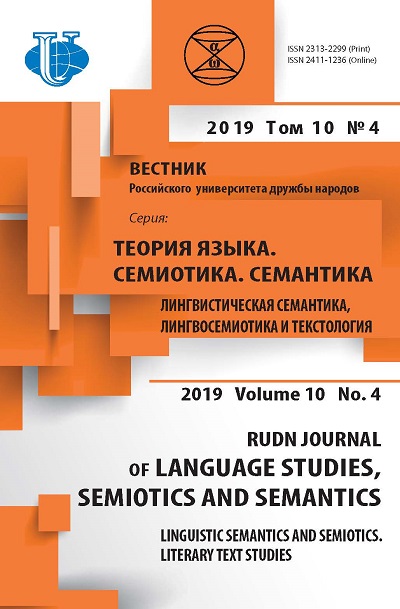Subject Variety of the Belgian Paroemias (on Lexicographical Material)
- Authors: Syomina P.S.1
-
Affiliations:
- Peoples’ Friendship University of Russia (RUDN University)
- Issue: Vol 10, No 4 (2019): Linguistic Semantics and Semiotics. Literary Text Studies
- Pages: 893-905
- Section: FUNCTIONAL SEMANTICS
- URL: https://journals.rudn.ru/semiotics-semantics/article/view/22775
- DOI: https://doi.org/10.22363/2313-2299-2019-10-4-893-905
- ID: 22775
Cite item
Full Text
Abstract
This article focuses on the main topics presented in the Belgian paroemias. In the paper, the paroemia is understood as a generic concept in relation to proverbs, sayings and signs. The author’s file of the Belgian French paroemies, taken by a continuous sampling method from the dictionary of proverbs and sayings of the Belgian francophony, is served as the material for the study. It is shown, how paroemias reflect the national character and features of the worldview of certain people. The relevance of the study is due to the necessity of the Belgians paroemiological world view description, because until now the thematic palette and description of the Belgian national character have been the subject of detailed study in neither Russian, nor Belgian linguistics.
Keywords
About the authors
Polina S. Syomina
Peoples’ Friendship University of Russia (RUDN University)
Author for correspondence.
Email: karpovapauline@gmail.ru
3 year post-graduate student in “Romance languages”
Miklukho-Maklaya str., 6, Moscow, Russian Federation, 117198References
- Lomakina, O.V. & Mokienko, V.M. (2016). The cognitive potential of the Ruthenian paroemias against the background of the Russian and Ukrainian languages, Rusin, 3 (45), 119—128. DOI: 10.17223 / 18572685/45/9. (In Russ.).
- Bayramova, L.K. & Ivanova, M.V. (2014). Russian culture in the “Axiological Phraseological Dictionary of the Russian Language”, Problems of history, philology, culture. Magnitogorsk State Technical University. G.I. Nosov, 3 (45), 10—12. (In Russ.).
- Firsova, N.M. (2004). On the national characters of the Spanish-speaking and English-speaking peoples in the comparative plan, Philological Sciences, 2, 51—58. (In Russ.).
- Kurguzenkova, J.V. & Nelyubova, N.Yu. (2012). Phraseological units with somatism components in the objectification of the process of food intake in French culture, Russian Journal of Linguistics, 1, 66—69. (In Russ.).
- Soldatkina, T.A. (2013). Basic concepts of the English and French Paremiological Foundation, Modern problems of science and education. Publishing House “Academy of Natural History”, 6. URL: https://www.science-education.ru/ru/article/view?id=10970 (accessed: 1.05.2019). (In Russ.).
- Speranskaya, A.N. (2014). Effective speech communication. Dictionary reference. Electronic edition. Siberian Federal University. Krasnoyarsk. (In Russ.).
- Alefirenko, N.F. & Semenenko, N.N. (2009). Phraseology and paremiology: A textbook for the bachelor's level of philological education. Moscow: Flint: Science. (In Russ.).
- Mokienko, V.M., Nikitina, T.G. & Nikolaev, V.K. (2010). Large dictionary of Russian sayings. Moscow: CJSC “OLMA Media Group”. (In Russ.).
- Semenenko, N.N. (2009). The case law of paroemia as a problem of semantic research, Bulletin of VolSU. Series 2: Linguistics, 2 (10), 17—23. (In Russ.).
- Lamiroy, Bé. (2006). Le français de Belgique et les locutions verbales figées. In: Revue belge de philologie et d'histoire, tome 84, fasc. 3, 2006. Langues et littératures modernes — Moderne taal en litterkunde. pp. 829—844; [Electronic resource] URL: https://www.persee.fr/doc/ rbph_0035-0818_2006_num_84_3_5046 (accessed: 18.12.2018)/ (In Franch).
- Nichiporchik, E.V. (2016). Reflection of value orientations in paromas: linguo-cognitive, comparative, and sociopsycholinguistic aspects [dissertation]. Minsk. (In Russ.).
- Lomakina, O.V. (2015). Phraseology in the language of L.N. Tolstoy: linguistic commentary and lexicographical description [dissertation]. St. Petersburg. (In Russ.).
- Ivanova, E.V. (2006). The world in Russian and English proverb. Tutorial. S]. St. Petersburg: Publishing house of S.-Petersburg. un-that; Filol. Faculty of St. Petersburg State University. (In Russ.).
- Lomakina, O.V. & Mokienko, V.M. (2018). Value Constants of the Russian Paremiology (on the Background of Ukrainian and Russian Languages), Rusin, 4 (54), 303—317. DOI: 10.17223 / 18572685/54/18. (In Russ.).
- Pirart, F. & Maury, P. (1989). Proverbes et dictons de Belgique francophone. Rivages. (In Franch).
- Montreynaud, F., Pierron, A. & Suzzonni, F. (2006). Dictionnaire de proverbes et dictions. Paris: Le Robert. (In Franch).
Supplementary files












